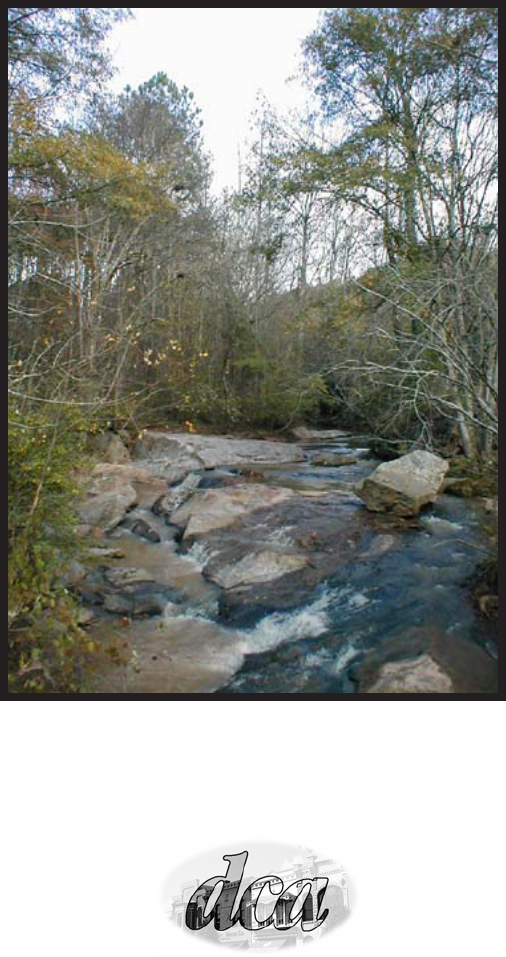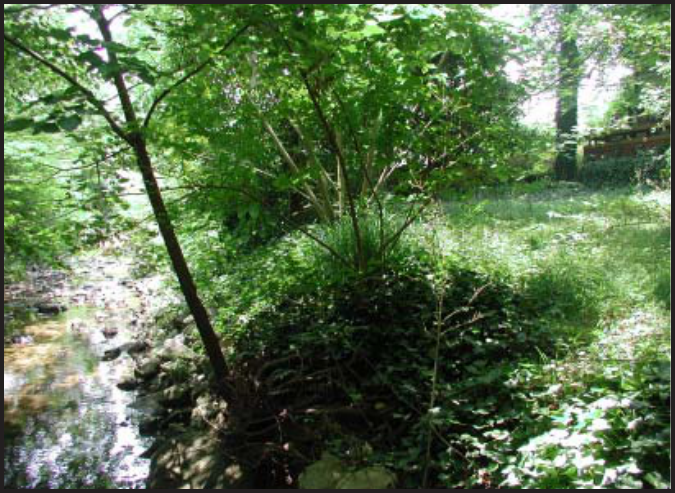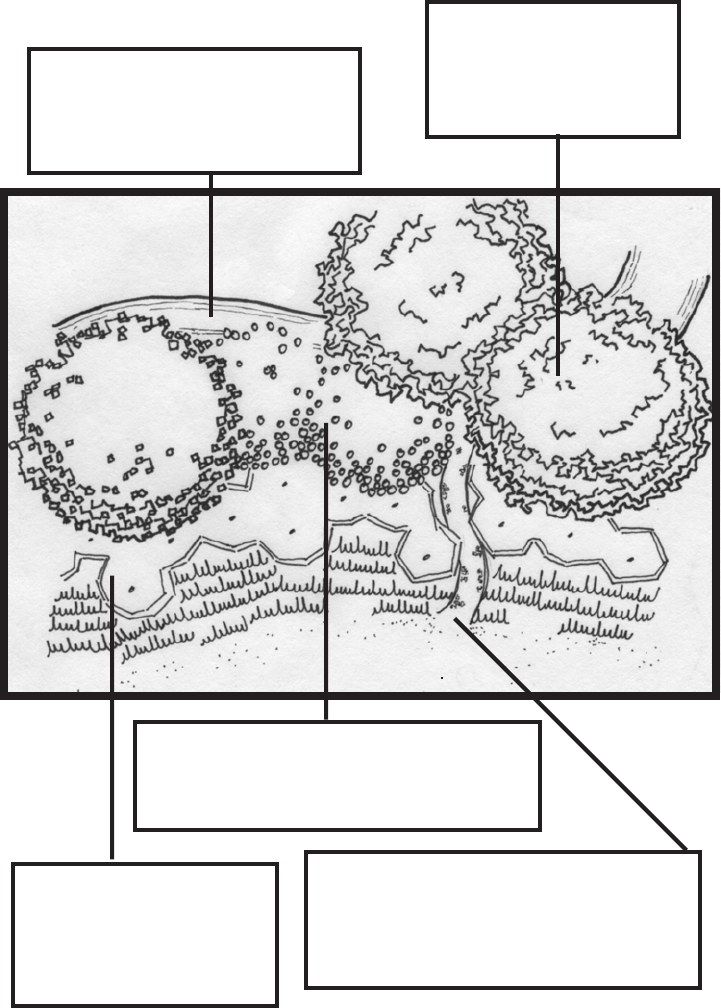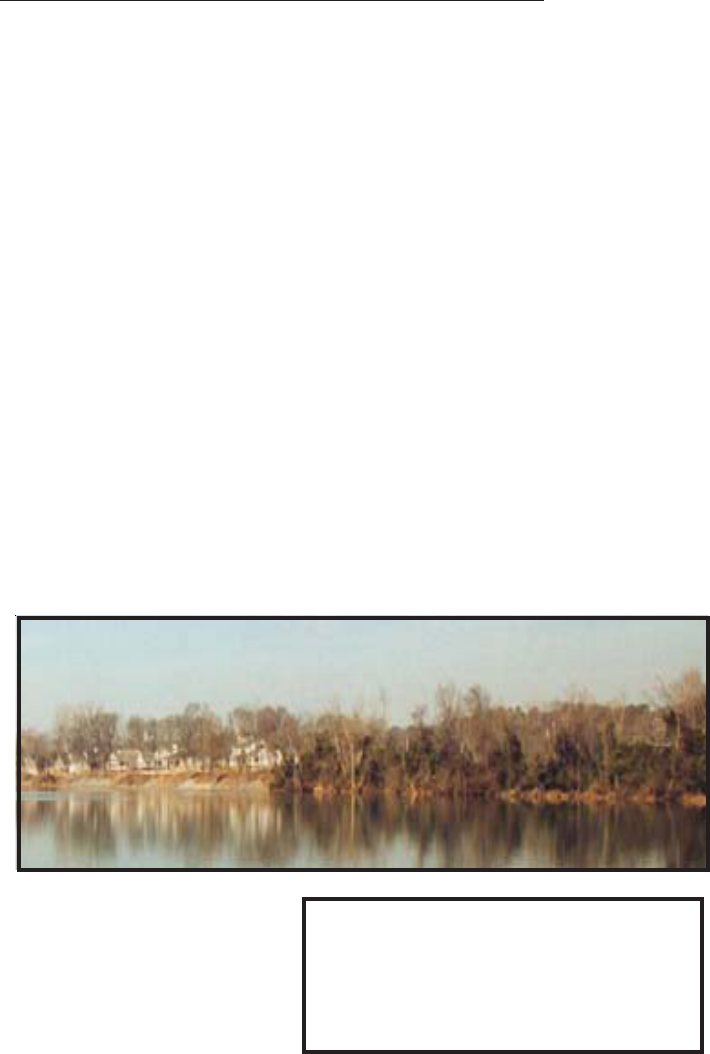
Backyard
Buffers
Protecting Habitat and
Water Quality
What is a buffer?
A buffer (also called a riparian buffer area or zone) is the strip of natural vegetation
along the bank of a stream, lake or other water body that separates the water from
developed areas such as lawns, buildings, roads, driveways, etc. Buffers can
include grass, shrubs, and trees, which hold the soil in place and act as living
filters of pollution. Without buffers, homes and residential neighborhoods can
contribute sediment, fertilizers, pesticides, metals, oil and other vehicle fluids, pet
waste and many other pollutants to nearby waters. Buffers also help prevent property
loss due to erosion.
If you have a stream, lake or other water body on your property, there are many
reasons to protect, preserve, and enhance the buffer zone around it. Buffers are
critical on all streams. Many residential areas are built around small streams
which feed larger streams and rivers and eventually reach drinking water intakes.
Preserving buffers on streams of all sizes not only protects these surface waters
but also allows water to percolate through the soil and replenish groundwater.
What are the state and local buffer requirements?
Georgia has a number of laws and regulations that apply to buffer zones, so the
required minimum buffer width on your property can vary. The Georgia Erosion
and Sedimentation Control Act restricts land disturbance and trimming of vegetation
within a 25 foot buffer adjacent to creeks, streams, rivers, saltwater marshes, and
most lakes and ponds, and within a 50 foot buffer on trout streams. Homeowners
may not cause any significant land disturbance within this buffer without a variance,
but may thin or trim vegetation so long as water quality and aquatic habitat are
protected and a natural canopy is left in sufficient quantity to provide shade on the
stream bed.
The Mountain and River Corridors Protection Act and the Georgia Planning Act require
some local governments to adopt a 100 foot buffer and restrict certain land uses
along various large river corridors in the state. Water supply reservoirs, streams that
flow into reservoirs, and streams above drinking water intakes may also require
wider buffer zones, depending on their distance from the reservoir or intake.
Many local governments have adopted ordinances that specify wider buffers than
the state minimum requirements. For specific information on buffer zone
requirements in your area, you should contact your city or county zoning and
development department. Some local governments also offer assistance with
stream bank restoration and erosion control.

How can I protect buffer zones and stream health on my property?
• Never mow to the edge of a stream or lake; let the buffer develop naturally;
• Plant appropriate native vegetation and cuttings in the buffer zone;
• Don’t dump anything in a stream, including grass clippings and other yard
waste, try home composting instead;
• Keep the water body clean by removing trash;
• Leave natural woody debris in a stream. It provides habitat and food for
aquatic communities;
• Use pesticides and fertilizers sparingly in your yard and not at all in the
buffer ;
• Keep septic systems in good working order to prevent contaminated runoff;
and
• Don’t change the course of a stream or try to use rocks or other
materials to stop stream bank erosion yourself. You can do more harm
than good.
Pesticides and fertilizers applied to the lawn above can harm the water
quality, cause algal blooms, and degrade habitat. However, the stream
bank has been allowed to naturally revegetate. Erosion is minimized,
pollutants are filtered out before reaching the stream, habitat for wildlife is
created, and shade is provided to keep water temperatures cooler.
Benefits increase with a wider buffer.

They preserve water quality by capturing
sediment and chemicals from stormwater
runoff, which protects our drinking water
They provide shade to
keep stream water
cooler and discourage
algae growth.
Why are healthy buffer zones
important?
They slow runoff to help
prevent flooding and
flood damage, saving
money for the property
owner and downstream
storm-water managers.
Healty buffer zones provide
natural habitat and movement
corridors for birds, mammals
and other wildlife.
Buffers stabilize stream banks
with their root systems and
prevent erosion.
and the aquatic habitat of fish and other
creatures.

Planning and creating a healthy
buffer zone
You will want to group some
plants together to provide
denser vegetation, better
habitat and more storm
water filtration at maturity.
Some trees should be
planted near the water’s
edge. Revegetation at the
water’s edge should be
allowed to occur naturally.
If you want to provide a path for access to
the water, it should be as narrow as
practical and covered with mulch or other
porous material to minimize erosion and
channeling of water in the buffer.
The buffer zone should be thought
of in layers moving from the stream
to the house and should be ordered:
trees, shrubs, groundcovers/
grasses, then maintained lawn.
If you want to maintain a view of the water,
you can create a “view corridor” of low-
growing vegetation in a selected area, while
still maintaining an effective buffer.

Planning and Creating an Effective Backyard Buffer
Before you begin work on creating or modifying your vegetated buffer strip, take
a look at how water flows off your property during a heavy rainstorm. The buffer
is most effective when runoff spreads out across it and does not flow in a
channel directly to the stream. Consider whether you need to divert water more
effectively into the buffer to achieve the best flow.
Next, look at how close your lawn comes to the stream or lake bank now. Many
people make the mistake of growing their lawn right down to the water’s edge,
when in fact a naturally vegetated buffer creates a more attractive landscape.
Lawns provide little, if any, habitat for birds and animals, and no benefits for the
water body. Think about how much lawn you really need, keeping in mind that
lawns require more care, water, fertilizers and pesticides than a natural buffer.
You have two choices for creating, restoring or expanding your buffer: let the
buffer area passively return to a natural state by creating a no-mow zone, or
actively revegetating the area with selected native and other plants. If you
select the first choice, you will find that birds, squirrels and other animals, as
well as wind and water, will help bring seeds, berries and nuts into the buffer
area. However, it will take some time for grasses, shrubs and trees to take root
and mature, so be patient. If the potential buffer site is just bare soil now, you
should plant grass seed covered with straw to prevent erosion during rain
events, and then allow other plants to become established.
Above, the neighborhood on the left has
eliminated the buffer zone and planted
grass to the river’s edge. The neighbor-
hood on the right has kept the buffer intact,
adding to the beauty of their property and
benefiting the health of the river.

Designing Your Own Buffer
If you want to take a more active role in the creation of your buffer, you should first
develop a planting plan. Remember that you will want to plant some
vegetation, especially shrubs and trees, in early spring when they are still
dormant or in the fall after the leaves have fallen. Also, you can create the
buffer in stages over time to spread out the work and expense of the project.
It is helpful to sketch out a design to determine how many plants are needed.
You can start your plan by drawing where you would like to plant grasses,
shrubs and trees, without worrying about the exact species at this stage. Do
consider the size (at maturity) of the plants you would prefer, however.
Generally, you should plant ground covers 1-3’ apart, shrubs 3-5’ apart, small
trees (up to 25’ at maturity) 15’ apart, and larger trees 25’ apart.
When selecting plants for your buffer, you will want to consider a number of
factors, including:
• Size of the plant at maturity, including height and width;
• Whether the plant is evergreen or deciduous (seasonal foliage);
• Whether the plant is slow, medium or fast growing;
• Color of foliage, flowers and berries;
• Time of year that plant blooms and produces seeds or fruit;
• Attraction of foliage to certain desirable insects (such as bees and
butterflies), birds and other animals;
• Resistance to insect pests and disease;
• Whether the plant prefers full sun, semi-shade or full shade, as this
factor will help to determine where in the buffer various plants would be
most appropriate;
• Watering requirements (native and/or drought resistant species are
preferred);
• What soil type the plant prefers, including pH range;
• Growing range (zone) for the plant, to ensure it is appropriate for your
area; and
• Whether the plant is native to your area or an imported variety
(whenever possible, desirable native plants should be used in the
buffer).
You should select a wide variety of plants, with a mixture of grasses, ground
covers, shrubs and trees. This will help decrease the spread of diseases and
provide you with attractively varied foliage. Also, select plants that flower and
bear fruit at various times during the growing season.

Internet resources
Georgia Wildlife Federation: http://www.gwf.org
National Wildlife Federation:
http://www.nwf.org/backyardwildlifehabitat/
Natural Resources Conservation Service:
http://www.nrcs.usda.gov/feature/backyard/
Wildlife Habitat Council:
http://www.wildlifehc.org/managementtools/backyard.cfm
Georgia Citizen Riparian Network:
http://www.riversalive.org/CRN/
Citizen_Riparian_Network.htm
Georgia EPD Adopt-A-Stream Program: http://www.riversalive.org/aas.htm
USEPA River Corridor and Wetland Restoration:
http://www.epa.gov/owow/restore/
USDA Stream Corridor Restoration: Principles, Processes and Practices:
http://
www.usda.gov/stream_restoration/
Georgia Center for Urban Agriculture:
http://www.griffin.peachnet.edu/urbanag/
homepage.shtml
Georgia Native Plant Society: http://www.gnps.org/
Coastal Plain Native Plant Society:
http://www.gnps.org/cpnps.htm
Georgia Wildlife Federation’s Native Plant site:
http://www.gwf.org/habitatplants.htm
Landscape Management Manual for Georgia Homeowners (ordering information): http://
www.p2ad.org/landmanual.html
NESPAL Native Plants and Landscaping:
http://nespal.cpes.peachnet.edu/Native/
Riparian Buffers In Your Backyard, For Chatham County And The Georgia Coast:
http://
www.thempc.com/Backyard%20buffers/Backyard%20Buffer_1.pdf
Smart Landscaping – A Georgia Native Plant Guide (Southface article Spring 2002):
http://www.southface.org/home/sfpubs/sfjv102/sfjv102-native-plants.htm
Georgia Integrated Pest Management (IPM) site:
http://www.gaipm.org/
USEPA Pesticides site:
http://www.epa.gov/pesticides
UGA Pesticide Safety for the Homeowner: http://www.ces.uga.edu/pubcd/L430-w.html
Earth 911 site for waste disposal and recycling locations, and much more: Call 1-800-
CLEANUP or go to:
http://www.cleanup.org
Georgia Department of Community Affairs:
http://www.dca.state.ga.us
Atlanta Clean Water Campaign:
http://www.cleanwatercampaign.org/
Georgia Environmental Protection Division: http://www.dnr.state.ga.us/dnr/environ/
UGA Cooperative Extension Service, for free assistance, useful publications, and other
valuable information:
http://www.ces.uga.edu/
Georgia Department of Community Affairs, Office of Environmental Management
60 Executive Park South, N.E. Atlanta, Ga. 30329
www.dca.state.ga.us/environmental
404-679-4940
